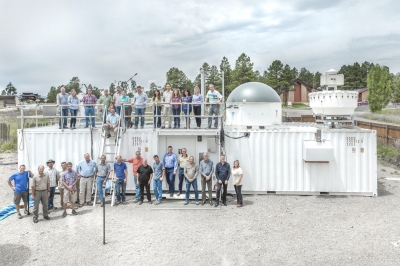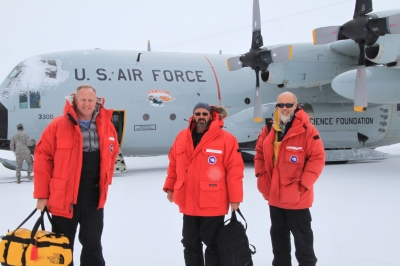AWARE Going to the Ends of the Earth to Help Improve Climate Science
Published: 14 September 2015
Extensive Modifications and Testing Complete, Instruments En Route to Antarctica

Antarctica is the highest, driest, coldest, and windiest continent. It contains 90% of the ice on Earth and could raise sea levels worldwide if it were to melt. Using satellite data, scientists recently discovered rapid changes in the West Antarctic region, yet there has been no substantial atmospheric science or climatological field work there since the 1950’s.
The satellite data show that Antarctic ice shelves have collapsed, triggering loss of more ice. How much, how soon is unknown. Much more data from multiple sources are needed to improve earth system models to predict how climate will continue to change.
This is a colossal challenge, and it is a monumental feat to research such a remote, harsh place. Accepting this challenge, the U.S. Department of Energy (DOE) Atmospheric Radiation Measurement (ARM) Climate Research Facility has spent years planning for the ARM West Antarctic Radiation Experiment, known as AWARE, which begins in late November with a set of equipment deployed to the West Antarctic Ice Sheet (WAIS). AWARE is a collaborative project between DOE and the National Science Foundation (NSF), which manages the U.S. Antarctic Program. The principal investigator of the AWARE campaign is Dan Lubin, from the Scripps Institution of Oceanography.
On the ice for 14 months in total from two locations, instrument experts and scientists will collect and analyze quantitative data about energy components, changing air masses, and cloud microphysical data. A suite of instruments on the WAIS will operate for 56 days, along with guest instrumentation, to begin the campaign. The second ARM Mobile Facility (AMF2) , using some of the most advanced atmospheric instrumentation, will be deployed from Antarctica’s McMurdo Station from January 2016 to January 2017.
Exceptional Logistics and Training

Experts spent months at a staging facility in Pagosa Springs, Colorado—apropos given its high elevation and dry, cold climate—developing, assembling, outfitting, and testing dozens of instruments, data systems, equipment, and enclosures to withstand the antarctic environment.
Los Alamos National Laboratory (LANL) mobile facility staff designed and led this effort. The LANL team worked closely with site hosts and co-designers from Hamelmann Communications, plus ARM instrument mentors from multiple DOE national laboratories and scientists from the partner organizations, to develop the facilities and train staff.
Teams customized 11 airtight steel shipping containers and vestibules to house and protect the infrastructure and staff in minus-40-degree temperatures and wind gusts up to 150 miles per hour.
The mobile facility and its instruments—some last deployed to study the balmy Pacific Ocean on a ship and others from varied locations—were extensively modified to operate in the antarctic environment.
A critical component of the beta test was the design and construction of the Self Kontained Instrument Platform, or SKIP, which will be deployed to WAIS. LANL operations staff relied heavily on their field experience to ensure the SKIP could accommodate a wide range of future deployment scenarios.
“This is by far one of the most challenging deployments we’ve done,” said Kim Nitschke, ARM Mobile Facilities and LANL manager. Contractors that manage Antarctic research for the United States told Nitschke that “this is the first time they’ve seen something with such scale, complexities, and extensive instrumentation as this deployment in Antarctica.”
Transported by ships and planes, it will take three months for the complex portable facilities to arrive at McMurdo. It is crucial that every element be carefully designed, constructed and operable since replacements are unfeasible in this remote locale.
A concerted effort, worldwide partners worked onsite at the staging facility in multiple phases of testing, including July’s full operations test.
Mobile Facilities Shipped to Antarctica

With successful completion of testing, the team dismantled and packed the facilities in August; AMF2 is now headed for Antarctica.
An experienced installation team composed of staff from LANL and the Australian Bureau of Meteorology will prepare the site infrastructure and set up the AMF shelters and instruments in November.
A full-time technician will maintain the instruments, which operate 24 hours a day, seven days a week through January 2017. In addition, weather balloons will be launched daily by local personnel.
Data from AWARE will be globally beneficial and will be vital in creating the first well-calibrated measurements of this kind acquired from Antarctica. Once processed, these data will be freely accessible through the ARM Data Archive.
“We’re on the precipice to pull off one of the best deployments we’ve ever done in one of the most challenging environments,” Nitschke said.
# # #
The ARM Climate Research Facility is a national scientific user facility funded through the U.S. Department of Energy’s Office of Science. The ARM Facility is operated by nine Department of Energy national laboratories, including Los Alamos National Laboratory, which manages ARM mobile facilities and Eastern North Atlantic site in the Azores.
The ARM Climate Research Facility is a DOE Office of Science user facility. The ARM Facility is operated by nine DOE national laboratories, including .
Keep up with the Atmospheric Observer
Updates on ARM news, events, and opportunities delivered to your inbox
ARM User Profile
ARM welcomes users from all institutions and nations. A free ARM user account is needed to access ARM data.


















